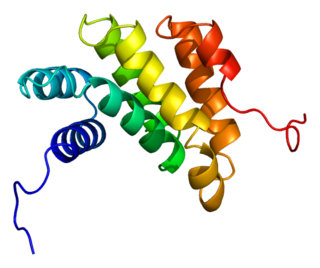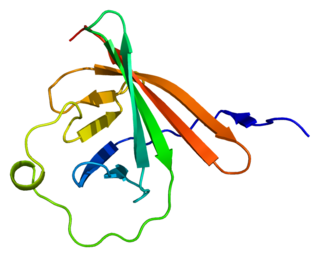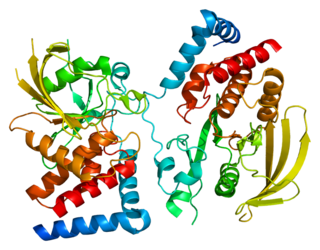
p73 is a protein related to the p53 tumor protein. Because of its structural resemblance to p53, it has also been considered a tumor suppressor. It is involved in cell cycle regulation, and induction of apoptosis. Like p53, p73 is characterized by the presence of different isoforms of the protein. This is explained by splice variants, and an alternative promoter in the DNA sequence.

A chromosomal fragile site is a specific heritable point on a chromosome that tends to form a gap or constriction and may tend to break when the cell is exposed to partial replication stress. Based on their frequency, fragile sites are classified as "common" or "rare". To date, more than 120 fragile sites have been identified in the human genome.

Testin also known as TESS is a protein that in humans is encoded by the TES gene located on chromosome 7. TES is a 47 kDa protein composed of 421 amino acids found at focal adhesions and is thought to have a role in regulation of cell motility. In addition to this, TES functions as a tumour suppressor. The TES gene is located within a fragile region of chromosome 7, and the promoter elements of the TES gene have been shown to be susceptible to methylation – this prevents the expression of the TES protein. TES came to greater prominence towards the end of 2007 as a potential mechanism for its tumour suppressor function was published.

WW domain-containing oxidoreductase is an enzyme that in humans is encoded by the WWOX gene.

Programmed cell death protein 4 is a protein that in humans is encoded by the PDCD4 gene. It is one of the targets of an oncomiR, MIRN21.

T-cell leukemia/lymphoma protein 1A is a protein that in humans is encoded by the TCL1A gene.

Hypermethylated in cancer 1 protein is a protein that in humans is encoded by the HIC1 gene.

Large tumor suppressor kinase 1 (LATS1) is an enzyme that in humans is encoded by the LATS1 gene.

Forkhead box protein G1 is a protein that in humans is encoded by the FOXG1 gene.

Histidine triad nucleotide-binding protein 1 also known as adenosine 5'-monophosphoramidase is an enzyme that in humans is encoded by the HINT1 gene.

Receptor-type tyrosine-protein phosphatase gamma is an enzyme that in humans is encoded by the PTPRG gene.

Solute carrier family 22 member 18 is a protein that in humans is encoded by the SLC22A18 gene.

Tumor suppressor candidate 3 is a protein that in humans is encoded by the TUSC3 gene.

Diphthamide biosynthesis protein 1 is a protein that in humans is encoded by the DPH1 gene. It encodes a protein that performs posttranslational modification of histidine-715 on eukaryotic translation elongation factor 2 to diphthamide. This modification appears to be important in the translation of Cyclin D in ovarian cells. DPH1 is mutated in 90% of ovarian cancers end stage, usually by loss of heterozygosity.

Zinc finger protein 33B is a protein that in humans is encoded by the ZNF33B gene.

Leucine zipper putative tumor suppressor 1 is a protein that, in humans, is encoded by the LZTS1 gene.

Zinc finger and SCAN domain-containing protein 21 is a protein that in humans is encoded by the ZSCAN21 gene.

Zinc finger protein 79 is a protein that in humans is encoded by the ZNF79 gene.

T-cell leukemia/lymphoma protein 1B is a protein that in humans is encoded by the TCL1B gene.

Transcription factor AP-2 gamma also known as AP2-gamma is a protein that in humans is encoded by the TFAP2C gene. AP2-gamma is a member of the activating protein 2 family of transcription factors.






























